
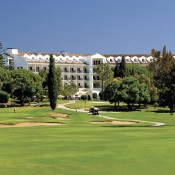

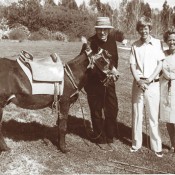
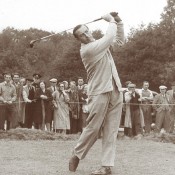
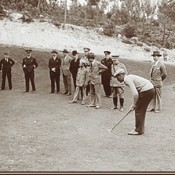
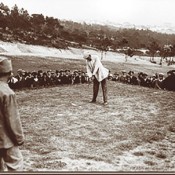
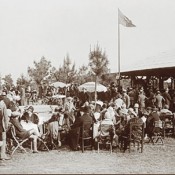
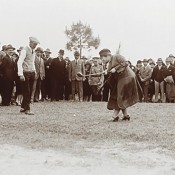

THE ORIGINAL CLUBHOUSE AT OPORTO GOLF CLUB
The dramatic rise of golf in Portugal since 1890
The oldest recorded 18-hole course in continental Europe opened in 1856 at Pau, inland from Biarritz in France’s Pyrénnées-Atlantiques region. Also, while not generally associated with a long history of golf, the game in Portugal actually dates back to the late 19th century.
Golf in Portugal was originally enjoyed by just a select few who were members of the British expatriate community living in and around Oporto and involved in the production of port wines and railway construction. Having brought with them many of their favourite sporting activities such as tennis, cricket and croquet they eventually discovered the right sort of terrain for golf. This was located just south of the Douro river-mouth and featured a layout that was perfect for a links course. It was also very accessible via the rail links that some of them were actually working on. As a result, in 1890, the nine holes of the Oporto Niblicks Golf Club, founded by just 24 members, came into being as the first course in the Iberian Peninsula and only the fifth in continental Europe.
By 1900 the club had negotiated with the local mayor, changed its name to Oporto Golf Club, transformed the sandy soil to grass and expanded to a full 18 holes. According to local news reports of the time, those early days were something to behold. Some accounts describe golfers playing as soon as they stepped off the train, hitting balls along the streets as they made their way to the course. Such scenes were then repeated as they made their way back again and there are smashing descriptions of an inevitable broken window or two along the way! Amongst those trying to avoiding the broken glass were some of the barefooted local caddies who from the local fishing community.
Soon after the turn of the century the English community associated with an English cable car company was established in Lisbon and they also sought to establish a golf club. The outcome was a six-hole layout along the banks of the River Tagus near the Torre de Belém. As the city expanded, though, this course only lasted six years; however, former members still gathered regularly at a small coffee-shop Café Londres which still stands today near the Campo Pequeno bull-ring. At that time the café stood in isolation and the golfers needed little encouragement to hit a few golf balls around the adjacent empty spaces. Of course, the city continued to grow and the club, by now called The Lisbon Sports Club, was again forced to move before eventually in 1922 settling at Ajuda in the west of Lisbon and today it is now located near Belas.
Thus golf slowly but surely expanded near the capital and although it did not make too much of an impression on the populace during those first few decades, it gradually established a niche among the élite. Golf was costly, time-consuming and mainly the domain of the `eccentric’ English. By 1929 a nine-hole course had opened at Estoril with a further nine holes being added there in 1945. Before then, in 1932, Miramar Golf Club near Oporto had also been established and a nine-hole layout built two years later. During the same year, as the sport’s popularity grew, another another nine-holer was established at Vidago. Moving offshore, to the Madeira archipelago, 1933 also saw a 9-hole, par-3 course built on the main island and nine full-size holes were constructed in 1937 at Santo da Serra.
Hard as it might be now to remember, in the very early 1960s foreign travel was still considerably restricted. This was not only due to cost but the amount of time required to be away from home and work commitments inevitably proved to be prohibitive. Eventually, however, mainly due to increasing affluence and the advent of the `package’ holiday, visitors regularly flocked to the sunshine and fabulous beaches of southern Europe. The attendant need to vide holiday accommodation that was to become such a flourishing business in the second half of the twentieth century was highly significant for the development of golf in Portugal.
Yet another member of the English community, the visionary Sir Henry Cotton, was responsible for the development of golf in the Algarve when he established in 1966 the now world-famous Penina Resort Championship course. This resulted in golf suddenly becoming a natural and enviable adjunct to the other tourist activities on offer in the region. Mild weather during the winter months meant that golfers could extend their playing season and still enjoy the game when their home courses were often unplayable or even closed. Not only was Sir Henry responsible for Penina, but he also drew up the original layouts for Vale do Lobo, Alto and Benamor.
Several other resort courses were subsequently developed in the south Vale do Lobo ` Ocean’ (1968); Vilamoura Old Course (1969); Penina `Resort’ course (1972); Quinta do Lago and the first 9 of Ria Formosa (1974). The Revolution saw somethuing of a hiatus on all fronts for a few years. However, after the country gradually settled down, the late 1970s and 80s saw a rush of new courses in Algarve with Palmares (1975); Vilamoura `Pinhal’ (1976); Penina `Academy’ (1977); Parque da Floresta (1987) and San Lorenzo (1988) bringing the total throughout Portugal to twenty-three courses by the end of that decade.
During the nineties the number of golf courses in Portugal more than doubled and by the turn of the millennium exceeded 50. The largest concentration is still in Algarve although, as Portuguese promoters identify what they recognise as the game’s potential, there are other several interesting golfing destinations in the north and central mainland regions, Madeira and the Azores.
Portugal is also proud to claim ownership of The Skeffington Cup, created in 1891 and named after the founder and first President of the Oporto Club Mr. Charles Skeffington. The Skeffington Cup is believed to be the most ancient golf trophy which has been played for uninterruptedly in the world! Such history and tradition underlines the beauty and value of how golf has developed in Portugal since those humble beginnings 125 years ago. Regardless of one’s perspective on this ever-present and contentious sport, golf is undeniably a game played in constant contact with Mother Nature and has become a complementary, integral dimension of nature. Portugal is a great example of how golf courses can establish valuable, undeveloped swathes of land within which finely balanced ecologies with wild varieties of plant and animal life are protected and thrive happily together. Links courses provide buffers between land and water, occupying terrain which is of little use for anything else and which, without golf, might be forever lost to the sea. The beauty of golf may be based on a similarity to life itself… good times and bad; love and hate; and, most of all the humility that is a feature of its successes and defeats. This helps to explain why the history of golf in Portugal over 125 years has become a strand of a nation’s evolving culture and why there is every reason to expect that the next hundred years will contribute even more to the colour and personality of Portugal.










